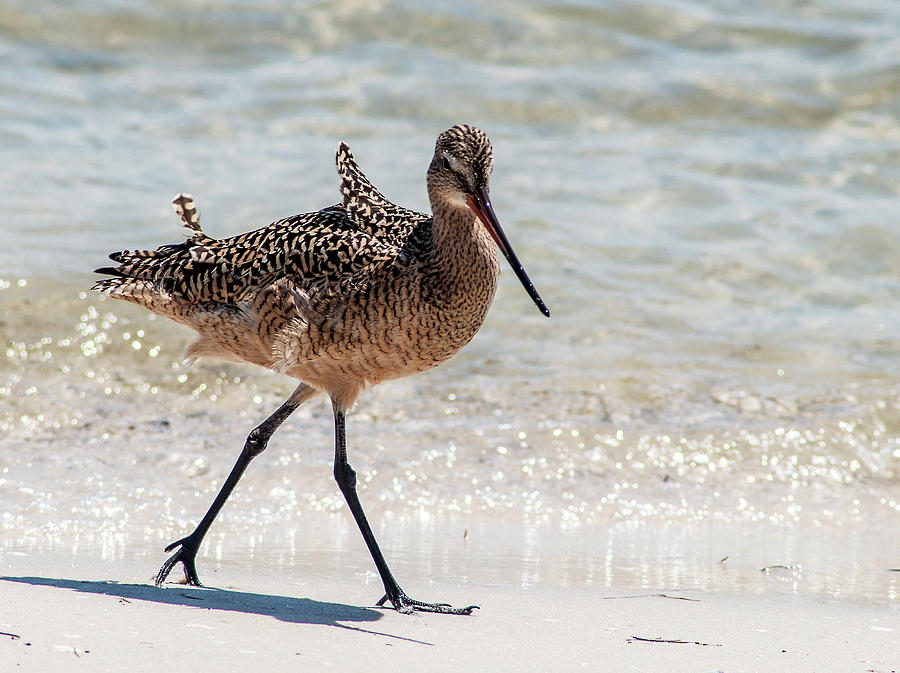The Marbled Godwit: A Comprehensive Overview
Share
The Marbled Godwit, scientifically known as Limosa fedoa, is a fascinating bird belonging to the order Charadriiformes and the family Scolopacidae. This article delves into the various aspects of this remarkable species, including its taxonomy, physical characteristics, habitat, diet, behavior, reproduction, and conservation status.
.jpg)
Taxonomy
The Marbled Godwit is classified under the following taxonomic hierarchy:
- Order: Charadriiformes
- Family: Scolopacidae
- Suborder: Charadrii
- Subfamily: Tringinae
- Species: Limosa fedoa
The type specimen was first described by Linnaeus in his work Syst. Nat., published in 1758. The species is known for its distinctive features and migratory patterns.
Physical Characteristics
The Marbled Godwit is a large shorebird, characterized by its long, slightly upturned bill, which is ideal for probing mud and sand for food. Adult birds typically exhibit a mottled brown and gray plumage, which provides excellent camouflage against their natural habitats. Their wings are long and pointed, allowing for agile flight during migration.

Habitat
Marbled Godwits breed in the grasslands and wetlands of North America, particularly in southern Alberta and southern Manitoba, extending south to South Dakota. They prefer areas with shallow water and abundant vegetation for nesting. During the winter months, these birds migrate to coastal regions, including central Lower California, Louisiana, and Georgia, and further south to Peru.

Diet
The diet of the Marbled Godwit primarily consists of invertebrates, such as worms, crustaceans, and insects. They forage by probing the mud with their long bills, using a combination of tactile and visual cues to locate their prey. This feeding behavior is crucial for their survival, especially during migration when energy reserves are vital.

Behavior
Marbled Godwits are known for their social behavior, often seen foraging in flocks. They are highly migratory, traveling long distances between breeding and wintering grounds. During the breeding season, males engage in elaborate courtship displays, which include aerial displays and vocalizations to attract females.

Reproduction
Breeding typically occurs in late spring to early summer. The female lays a clutch of 4 eggs in a shallow scrape on the ground, often well-hidden among grasses. Both parents share incubation duties, which lasts about 23 days. Once hatched, the chicks are precocial, meaning they are able to walk and feed themselves shortly after birth.
Conservation Status
The Marbled Godwit is currently classified as a species of least concern by the IUCN. However, habitat loss due to agricultural expansion and wetland drainage poses significant threats to their populations. Conservation efforts are essential to ensure the survival of this species, particularly in their breeding and migratory habitats.
Birdwatching Tips
For birdwatchers interested in observing the Marbled Godwit, the best time to spot them is during migration in the spring and fall. Coastal areas, wetlands, and mudflats are ideal locations. Using binoculars and a field guide can enhance the experience, allowing enthusiasts to appreciate the bird's unique characteristics and behaviors.
The Marbled Godwit is not just a beautiful bird; it plays a vital role in its ecosystem by helping to control invertebrate populations and serving as an indicator of environmental health. Observing these birds in their natural habitat can be a rewarding experience, offering insights into the complexities of avian life and the importance of conservation efforts.
In summary, the Marbled Godwit is a remarkable species that showcases the beauty and diversity of shorebirds. Its migratory patterns, feeding habits, and social behaviors make it a fascinating subject for both birdwatchers and researchers alike. As we continue to study and protect these birds, we gain a deeper understanding of the intricate web of life that sustains our planet.